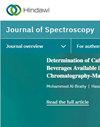沙叶树皮和印楝叶提取物在大鼠体内的GC-MS分析、抗糖尿病和抗氧化活性
IF 2.1
4区 化学
Q4 BIOCHEMICAL RESEARCH METHODS
引用次数: 0
摘要
本研究采用气相色谱-质谱联用技术对海地黄茎皮和印楝叶氢乙醇(80%)提取物的化学成分进行初步鉴定,并对其抗氧化和抗糖尿病作用进行筛选。腹腔注射四氧嘧啶(150 mg/kg·bw)诱导糖尿病。每组6只,分别给予提取物(400 mg/kg·bw) 28 d。结果与阳性对照组和阴性对照组动物进行比较。治疗后,采集血液,测定血糖水平、血脂、肝肾功能指标,评估DPPH自由基清除能力。植物化学研究表明,提取物富含多种次生代谢物,如酚类、皂苷、三萜、生物碱、黄酮类、甾醇、脂肪酸、硅氧烷衍生物和蒽醌等,具有不同浓度的抗氧化和抗糖尿病特性。生物筛选结果表明,两种提取物在DPPH筛选中均表现出清除自由基的能力,其中荆刺茎皮提取物(91±0.02%)对DPPH的清除能力显著高于荆刺叶提取物(55±0.03%),IC50为0.023±0.03 g/mL,低于参比药没食子酸丙酯(0.077±0.03 g/mL)。两种提取物均显著降低糖尿病大鼠血糖浓度(p < 0.05)。但籼稻叶提取物的降低率(52%)高于塞内加尔栎茎皮提取物(37%)。与糖尿病对照组相比,胆固醇、LDL、甘油三酯、总蛋白、白蛋白、尿素、肌酐、天冬氨酸转氨酶(AST)和丙氨酸转氨酶(ALT)水平也显著降低(p < 0.05)。然而,高密度脂蛋白的浓度略有升高。总之,这两种提取物对糖尿病大鼠具有显著的抗糖尿病和抗氧化作用。由于氧化应激与高血糖有关,提取物所显示的抗氧化活性将为抗糖尿病治疗提供额外的益处。本文章由计算机程序翻译,如有差异,请以英文原文为准。
GC-MS Phytochemical Profiling, Antidiabetic, and Antioxidant Activities of Khaya senegalensis Stem Bark and Azadirachta indica Leaves Extracts in Rats
This study was performed to evaluate phytochemical composition of Khaya senegalensis stem bark and Azadirachta indica leaf hydroethanolic (80%) extracts using GC-MS technique as a tentative identification method and screen for antioxidant and antidiabetic properties in Wistar rats. Diabetes was induced by intraperitoneal injection of alloxan (150 mg/kg·bw). Animals were divided into groups of six and treated by extracts (400 mg/kg·bw) for 28 days. The results compared with positive and negative control groups of animals. After treatment, blood samples were collected to determine the blood glucose level, lipid profile, liver and kidney function markers, and DPPH free radical scavenging activity was evaluated. Phytochemical investigations revealed that extracts were enriched with a wide range of secondary metabolites such as phenols, saponins, triterpenes, alkaloids, flavonoids, sterols, fatty acids, siloxane derivatives, and anthraquinones in diverse concentrations with reported antioxidant and antidiabetic properties. Biological screening results indicated that both extracts exhibited free-radical scavenging property in DPPH screening, and in that, K. senegalensis stem bark extract (91 ± 0.02%) showed greater reduction than A. indica leaf extract (55 ± 0.03%), with an IC50 of 0.023 ± 0.03 g/mL, which was lower than the reference drug propylgallate (0.077 ± 0.03 g/mL). Both the extracts remarkably reduced the blood glucose concentration in diabetic rats (
p
<
0.05
). However, A. indica leaf extract showed greater reduction (52%) than K. senegalensis stem bark extract (37%). Similarly, the cholesterol, LDL, triglyceride, total protein, albumin, urea, creatinine, aspartate aminotransferase (AST), and alanine aminotransferase (ALT) levels decreased significantly (
p
<
0.05
), in comparison to diabetic control animals. However, the concentrations of HDL slightly increased. Overall, both extracts showed significant antidiabetic and antioxidant potential in diabetic rats. As oxidative stress is associated with the hyperglycemia, the antioxidant activity displayed by the extracts will provide additional benefits in the antidiabetic therapy.
求助全文
通过发布文献求助,成功后即可免费获取论文全文。
去求助
来源期刊

Journal of Spectroscopy
BIOCHEMICAL RESEARCH METHODS-SPECTROSCOPY
CiteScore
3.00
自引率
0.00%
发文量
37
审稿时长
15 weeks
期刊介绍:
Journal of Spectroscopy (formerly titled Spectroscopy: An International Journal) is a peer-reviewed, open access journal that publishes original research articles as well as review articles in all areas of spectroscopy.
 求助内容:
求助内容: 应助结果提醒方式:
应助结果提醒方式:


